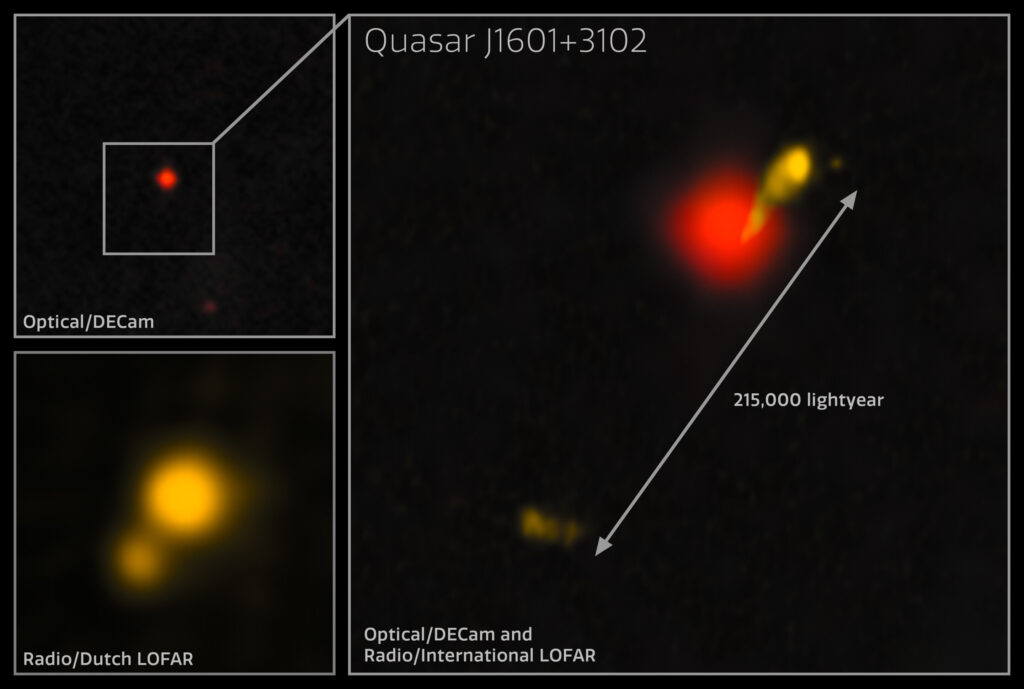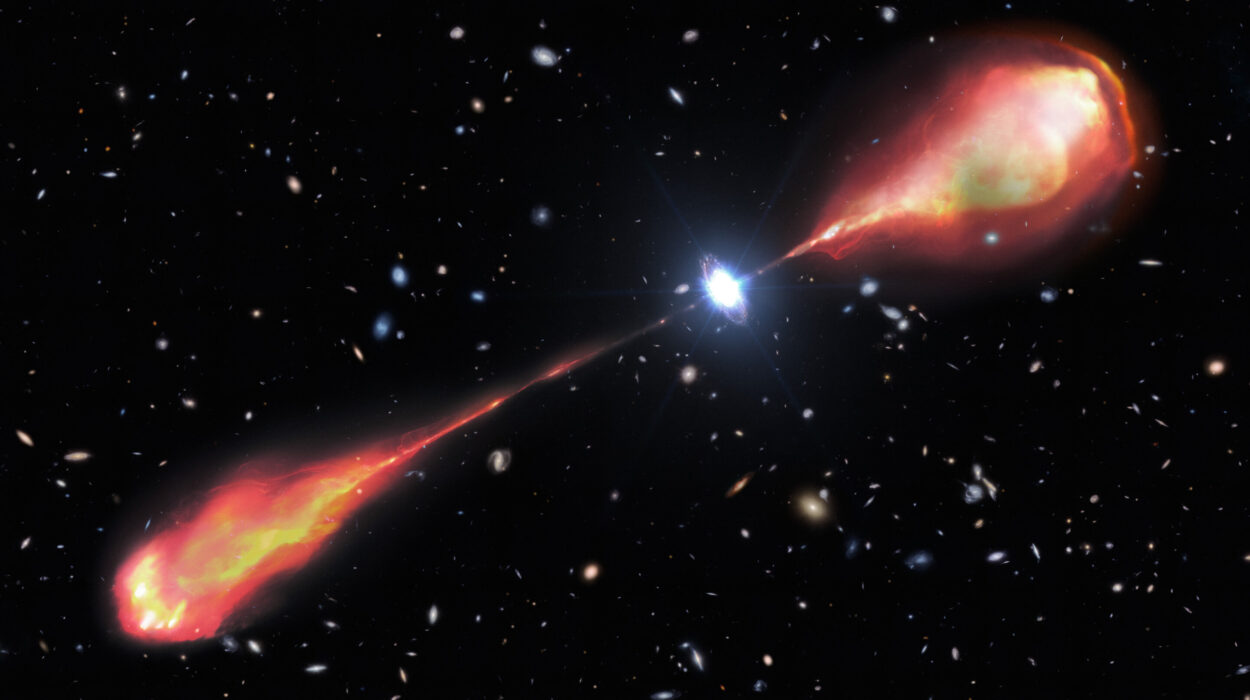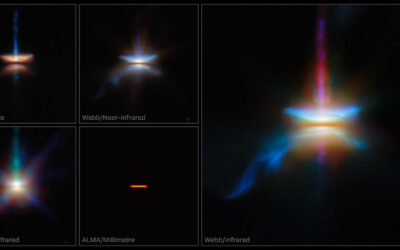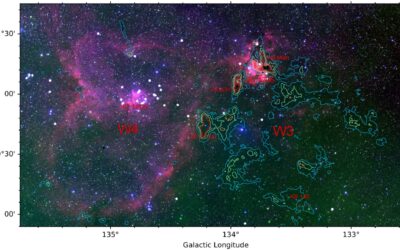Astronomers have long known that most galaxies, including our own Milky Way, harbor massive black holes at their centers. These black holes, while invisible themselves, create observable phenomena as gas and dust fall into them, releasing enormous amounts of energy. This process powers luminous galactic centers, called quasars, which are among the most powerful and energetic objects in the universe. As matter spirals into the black hole, it forms a hot accretion disk, and the intense friction in this disk causes jets of energetic matter to be expelled at nearly the speed of light. These jets of high-energy particles, often visible in radio wavelengths, are one of the defining characteristics of quasars and can be detected by radio telescopes even from vast distances.
While quasars and their associated radio jets are relatively common in the local universe, they have been elusive in the distant, early universe—until recently. A breakthrough discovery has revealed a massive two-lobed radio jet spanning an astonishing 200,000 light-years, which is more than twice the width of the Milky Way. This marks the largest radio jet ever discovered at such an early stage in the universe’s history. The discovery provides a unique opportunity to study the mechanisms behind the formation of these powerful jets and the impact they have on galaxy evolution.
The radio jet was first identified using the Low Frequency Array (LOFAR), a network of radio telescopes spread across Europe. LOFAR, with its ability to detect radio emissions at low frequencies, was crucial in picking up the faint signals of this distant quasar. Subsequent observations were made in other wavelengths to paint a more complete picture of the quasar and its powerful jet. Observations in the near-infrared were conducted using the Gemini Near-Infrared Spectrograph (GNIRS), which is mounted on the Gemini North telescope at the International Gemini Observatory in Hawaii. Optical observations were also made with the Hobby Eberly Telescope, providing additional data for the research team.
This combination of observational tools helped the team gain a deeper understanding of the quasar powering the radio jet. Anniek Gloudemans, a postdoctoral research fellow at NOIRLab and the lead author of the study, explains that the aim of their research was to better understand how the first radio jets formed in the early universe and how these jets influenced the galaxies around them. “We were searching for quasars with strong radio jets in the early universe, which helps us understand how and when the first jets are formed and how they impact the evolution of galaxies,” she says.
The quasar responsible for the massive radio jet, named J1601+3102, is located in a galaxy that formed when the universe was less than 1.2 billion years old—about 9% of the universe’s current age. Quasars, in general, can have black holes that weigh billions of times the mass of the Sun. However, J1601+3102‘s black hole is relatively small in comparison, with a mass of around 450 million times that of the Sun. Despite this smaller mass, the quasar produces an extraordinary radio jet, offering key insights into how such powerful jets can be formed even with a modest-sized black hole.
To understand the specific characteristics of the quasar, such as its mass and the rate at which it is consuming matter, the team looked for a signature known as the MgII broad emission line. This emission line, typically found in the ultraviolet range, was detected in the near-infrared because of the expansion of the universe. As light travels through space, it gets stretched due to the expanding universe, a phenomenon known as redshift. This means that light from distant quasars, which is typically emitted in the ultraviolet range, arrives on Earth at longer wavelengths. By using GNIRS, the team was able to detect this signal and determine the mass and accretion rate of the black hole.

One of the most intriguing aspects of this discovery is that the two radio jets emanating from the quasar are asymmetrical. The jets are uneven both in their brightness and in the distance they stretch from the quasar. This suggests that something in the quasar’s environment is influencing the jets, causing them to behave in unexpected ways. “Interestingly, the quasar powering this massive radio jet does not have an extreme black hole mass compared to other quasars,” Gloudemans notes. “This seems to indicate that you don’t necessarily need an exceptionally massive black hole or accretion rate to generate such powerful jets in the early universe.”
The relatively small size of J1601+3102‘s black hole challenges previous assumptions that only extremely massive black holes were capable of producing such enormous radio jets. This suggests that the conditions required for jet formation in the early universe may be more varied than scientists once thought, and that a variety of factors may contribute to the production of powerful jets.
Until now, large radio jets have been relatively rare in the early universe. One of the main reasons for this is the presence of the cosmic microwave background (CMB)—the faint, pervasive radiation left over from the Big Bang. The CMB creates a sort of “fog” that can interfere with the radio light from distant objects, making it difficult to detect such faint signals. However, the sheer size and energy of the radio jet from J1601+3102 make it an exception. “It’s only because this object is so extreme that we can observe it from Earth, even though it’s really far away,” Gloudemans explains. This finding demonstrates the power of combining different types of telescopes operating at various wavelengths to overcome these challenges and reveal distant, early-universe phenomena.
The discovery of the 200,000-light-year radio jet has sparked a range of new questions about the formation and evolution of quasars and their jets. For instance, scientists are eager to understand why some quasars produce such enormous radio jets while others do not, and what conditions in the early universe might have led to the formation of such powerful jets. Although the exact mechanisms behind jet formation remain unclear, the discovery of J1601+3102 provides valuable clues.
As the team continues their research, they are investigating how these early radio jets might have affected the galaxies around them. The energy released by the jets could have played a significant role in shaping the surrounding environment, potentially influencing the formation of stars and galaxies. By studying these jets, astronomers hope to gain a deeper understanding of the early universe and the complex processes that shaped it.
In addition to advancing our knowledge of quasars, this discovery highlights the importance of international collaboration in modern astronomy. The combination of data from LOFAR, Gemini North, and the Hobby Eberly Telescope underscores the power of using multiple observational tools across different wavelengths to explore the universe. Each telescope brings its own unique capabilities, allowing astronomers to capture a more complete picture of distant objects like J1601+3102.
While much has been learned from this discovery, many questions remain. How do powerful radio jets like the one found in J1601+3102 compare to other quasars? What exactly causes some quasars to produce such large and energetic jets? And what role did these jets play in the evolution of galaxies in the early universe? As astronomers continue to use a variety of instruments to probe the distant reaches of the cosmos, these questions will likely form the basis of ongoing research for years to come.
Thanks to the collaborative efforts of researchers and the advanced telescopes at their disposal, we are one step closer to answering these questions and gaining a more complete understanding of the early universe. The discovery of such a massive radio jet from a quasar that formed just 1.2 billion years after the Big Bang is a major milestone in the field of astronomy, offering new insights into the formation of the first large-scale jets in the universe and the complex relationship between black holes, quasars, and their host galaxies. As technology and observational techniques continue to improve, it is likely that even more remarkable discoveries await, shedding further light on the mysteries of the cosmos.
More information: Monster radio jet (>66 kpc) observed in quasar at z ∼ 5, Astrophysical Journal Letters (2025). DOI: 10.3847/2041-8213/ad9609






